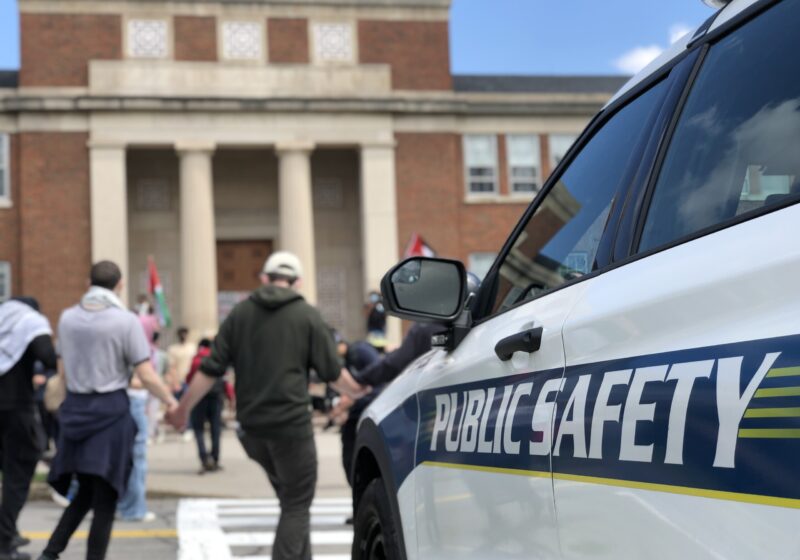When a group of six saxophonists and a bare bones rhythm section make you wish you were in the middle of a small, intimate jazz club in the heart of a big city with a glass of wine in hand, you know someone’s done something right.
That would the Eastman School of Music jazz saxophone students and Ramon Ricker, director of the student jazz saxophone ensemble called Saxology.
The group, which formed in 1980 as an offshoot of the professional jazz group Supersax, has been an innovative way to explore modern jazz and to show off the highly talented saxophone students who study at the Eastman School of Music. Saxology has garnered awards such as Downbeat Magazine’s Best College Instrumental Jazz Group each of the four years they’ve entered starting in 1981, and have sent their alumni off to some of the most famous jazz ensembles in the country, including the bands of Count Basie, Frank Sinatra and Wynton Maralis, amidst a long list.
They’ve also spread the love to Germany, Canada, Switzerland and the United States through tours and jazz festival appearances, and have recorded under the Advance Music label and Marc records.
With such a level of excellence, it’s no wonder both members of the saxophone faculty, Ricker and Walt Weiskopf made appearances with the group this past Monday night at Kilbourn Hall. Whole-heartedly playing their best while interactively fusing with the group was a sight to be seen, and to be heard. The students rose to the occasion, and so did the pros.
Though Ricker, whose style stole the breath of the audience in his orchestration of “Gaviota,” and Weiskopf, who showed the flawless expression of a modern city jazzer, were easy to pick out among the students, the students each replied with their own charisma flowing through their instruments.
Jose Encarnacion, a saxophonist from Puerto Rico, aggressively took on each solo with his rustic looking tenor sax. His playing was indeed inspired by more modern jazz, as could be heard in “Clare is There,” which had a big band swing feel to it. He chose not to use the typical “blue” notes associated with that style and successfully added his style as another layer upon the chart.
He was well matched to duo Weiskopf’s modern style in the tune “Refraction.” Kirsten Edkins’s tenor sax playing had a sensual sound to it in the tune “Creature Feature,” where even her fast passages sounded like silk.
Given that “Footprints,” the famous Wayne Shorter tune, is in a minor key, Matt Vashlishan picked up the audience with his energetically bright alto sax sound. Matt Pivec used the soprano sax to sing out musically and thoughtfully to the audience, not trying to show off technique, but making musical and harmonic judgments.
His high range on the horn was impressive, especially one note that he reached in a whisper and slowly increased its intensity with controlled vibrato. One could have mistaken him for an opera singer at that moment.
Had my eyes been closed, I might have mistaken Shirantha Beddage’s baritone sax playing for a tenor sax. The clarity and tone quality of his playing defied the baritone’s natural tendency to be the unrefined, capricious cousin of the tenor.
Giving all the credit to the saxophone players would be a crime. The rhythm section pulled out all the stops and made a huge impression through the wall of saxophonists in front of them. Los Angeles bassist Ryan Kotler opened the concert with a funky bass line, and continued to impress with clearly articulated solos, a difficult task on the bass.
Dalton Ridenhour managed to steal a few moments of glory with his piano solos in “Footprints” and “Outsider.” Grooving his way through the concert, Aaron Staebell finished up the concert with a creative and different drum solo, the only clue to this would have been the black hat he wore for the entirety of the concert.
Many of the tunes had been commissioned for Saxology by composers such as Jim McNeely, Bob Mintzer and Weiskopf himself.
Instrumentation included a piece for three tenors and two baritone saxophones, assisted by Matt Stuver, and a short stint on the flute by two of the players on one of Weiskopf’s tunes. Though many of the tunes seemed avant-garde at times, there was a unity to each selection and a good balance of melody and modern jazz harmony. Though Kilbourn Hall’s conservative stage is not an appropriate setting for such an intimate and fun group as Saxology, they managed to impress and entertain this past Monday night. Perhaps one day, we’ll be able to see them in that smoky city jazz club with a glass of fine red wine waiting at the bar.
Reguero can be reached at
areguero@campustimes.org.

